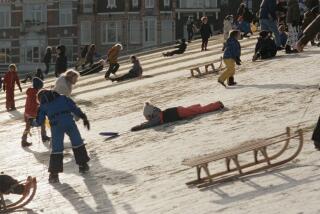Nazis Paid Bounty Hunters to Turn In Jews, Book Says
- Share via
AMSTERDAM — Dutch bounty hunters in the pay of the Nazis captured thousands of Dutch men, women and children during World War II and sent them to their deaths in concentration camps, a new book says.
“A Price on Their Heads,” by Dutch author Ad van Liempt, highlights a dark page in Dutch history -- a band of 54 middle-aged men who scoured the land in search of Jews in hiding.
Van Liempt asserts that 8,000 to 9,000 people -- three times more than earlier estimates -- were turned in for cash.
The findings could help explain why the 108,000 Dutch Jews forced out of their homes totaled far more per capita than in Belgium or France, said David Barnouw of the Netherlands Institute for War Documentation.
“What his work reveals is that, contrary to earlier beliefs, it was largely the Dutch themselves and not the Germans who turned in the Jews,” Barnouw said.
Van Liempt said in an interview that he was shocked by the extent of this “painful chapter of human betrayal” in his country, famous for being the place where Anne Frank hid for two years.
Van Liempt takes a close look at the bounty hunters, describing them as family types, often unemployed or in low-end jobs, who volunteered for the work out of greed and hatred of Jews and knew that their victims would probably be killed.
“The Dutch Department,” as the Nazis called it, was also known as the “Colonne Henneicke,” after its leader, Wim Henneicke. He had been trafficking in stolen Jewish property until the Nazis began offering cash for Jewish prisoners.
Workers were paid about 15 guilders a week, or $75 at today’s exchange rate, plus 7.50 guilders or $37.50 per captured Jew, van Liempt writes.
He says that to make a man named David Sanders reveal where his children were, they knocked out his teeth, and that they traveled for days to capture a 3-year-old girl, Floortje Citroen, who was later gassed at a camp in Sobibor, Poland.
The hunters would pose as friends or relatives to trick people into revealing hiding places and would use papers taken from captives to find new victims.
Van Liempt says he pored over 450,000 prosecution files on Nazi sympathizers, many of them kept secret until recently. A few perpetrators received the death penalty after the war, but many more fled to Germany and elsewhere.
One is known to be alive in Holland but is 90 and too incoherent to recall the events, van Liempt said.
Other than Henneicke and his partner, Willem Briede, the names of the bounty hunters have been changed to protect the privacy of their children.
“After the war, the Dutch children of collaborators were unfairly punished for the deeds of their parents,” van Liempt said. “Some of them are still traumatized today. I didn’t want to contribute to that.”
More to Read
Sign up for Essential California
The most important California stories and recommendations in your inbox every morning.
You may occasionally receive promotional content from the Los Angeles Times.










